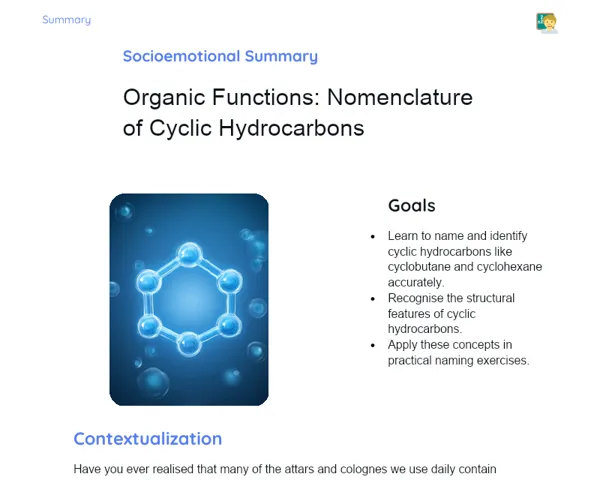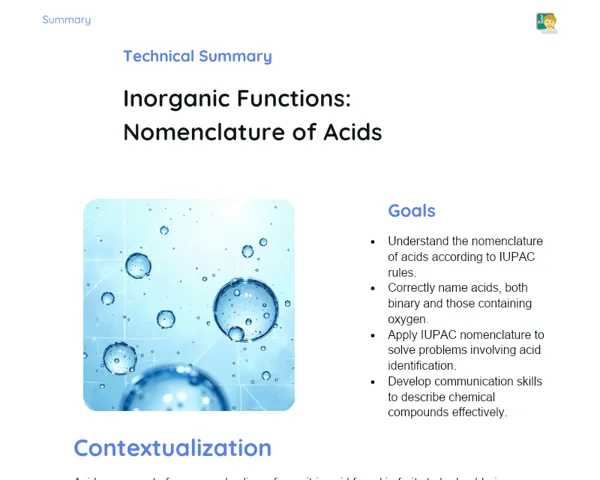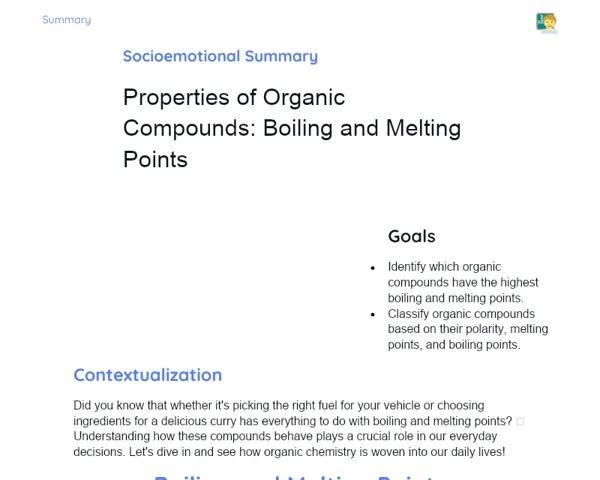Objectives
1. 🎯 Grasp how esters are formed through the reaction between carboxylic acids and alcohols.
2. 🎯 Recognize the physical and chemical properties of esters, and distinguish them from other organic compounds.
3. 🎯 Utilize theoretical knowledge about esters in everyday situations.
Contextualization
Did you know that esters play a vital role in our daily lives? These molecules not only contribute to the delightful aroma and flavor of various foods and drinks but are also essential in manufacturing plastics, solvents, and even fuels. The capability of esters to replicate various natural scents makes them a preferred choice in numerous industrial and consumer products. By familiarizing yourself with their properties and reactions, you're unlocking opportunities for innovation and practical applications in organic chemistry.
Important Topics
Formation of Esters
Esters are produced when a carboxylic acid reacts with an alcohol, resulting in the elimination of a water molecule. This process is termed esterification. During esterification, the hydroxyl group of the carboxylic acid reacts with the hydrogen atom from the hydroxyl group of the alcohol to form an ester bond, thus releasing water. Strong acids such as sulfuric acid are used as catalysts to speed up this reaction.
-
Reaction between carboxylic acid and alcohol: The structure of acids and alcohols interact to create an ester and water.
-
Catalyst: An example is sulfuric acid, which expedites ester formation.
-
Industrial significance: The formation of esters is pivotal in the production of various chemicals and in the food industry for flavor creation.
Properties of Esters
Esters possess distinct physical and chemical properties that set them apart from other organic compounds. They are typically colorless and volatile liquids, boiling at lower temperatures than their parent carboxylic acids or alcohols. Furthermore, esters often emit pleasant scents, making them invaluable in the fragrance and food industries.
-
Low boiling point: This characteristic enhances their use in perfumes and flavorings.
-
Aroma and flavor: They enhance the tastes and aromas of fruits and numerous processed products.
-
Solubility: Generally soluble in organic solvents and less soluble in water, making them useful in perfumes and fragrances.
Practical Applications of Esters
Thanks to their unique properties, esters find a plethora of practical applications. They are utilized in the food industry for flavoring, the pharmaceutical industry for drug synthesis, and in the production of plastics. They also play a significant role in biodiesel production, where transesterification of vegetable oils with methanol yields fatty acid esters that are used as renewable fuels.
-
Food industry: Used as flavoring and aromatic additives.
-
Pharmaceutical industry: Key components in numerous medications.
-
Biodiesel: Generation of renewable fuel through the transesterification of vegetable oils.
Key Terms
-
Esters: Organic compounds derived from the reaction of carboxylic acids and alcohols, characterized by a carbonyl group connected to an oxygen atom, which further links to an alkyl or aryl group.
-
Esterification: A chemical reaction which produces esters from a carboxylic acid and an alcohol with the release of water.
-
Flavorings: Substances that give aroma or flavor to food, often derived from esters due to their aromatic nature.
For Reflection
-
How does the structure of esters affect their properties and applications across various sectors?
-
Why are esters preferred for adding aroma and flavor to products over other compounds?
-
In what ways can a better understanding of ester formation reactions lead to progress in biofuel production and other sustainable initiatives?
Important Conclusions
-
We covered how esters are generated from the reaction of carboxylic acids and alcohols, a process known as esterification. This chemical transformation is not only intriguing but also crucial in various industrial and natural processes.
-
We examined the unique properties of esters that render them significant in the food, pharmaceutical, and fragrance industries. Their pleasant fragrance and low boiling point make them particularly suited for these applications.
-
We discussed how knowledge of ester properties can be applied in everyday contexts, such as in cooking and creating perfumes, highlighting the practical relevance of organic chemistry.
To Exercise Knowledge
- Create an 'Aroma Diary': For a week, jot down the scents around you and try to identify those that might come from esters. 2. Conduct an experiment! Set up a basic esterification lab at home using vinegar and isopropyl alcohol to create a simple ester. 3. Draw a conceptual map linking the structure of esters with their properties and real-world applications, particularly in the food and fragrance sectors.
Challenge
Perfumer's Challenge: Using only safe ingredients available at home (like fruits, spices, and alcohol), attempt to make a homemade perfume. Document your process and explain which esters you think you've created and the reasoning behind your choice of ingredients.
Study Tips
-
Utilize visual aids like videos and infographics to better grasp the structure and formation of esters. Chemistry websites and educational applications can be quite helpful.
-
Try explaining the concept of esters to a friend or family member. Teaching is one of the most effective ways to learn and remember information.
-
Join online discussions or study groups focusing on organic chemistry. Engaging with fellow students can help clarify doubts and provide diverse perspectives on the subject.



